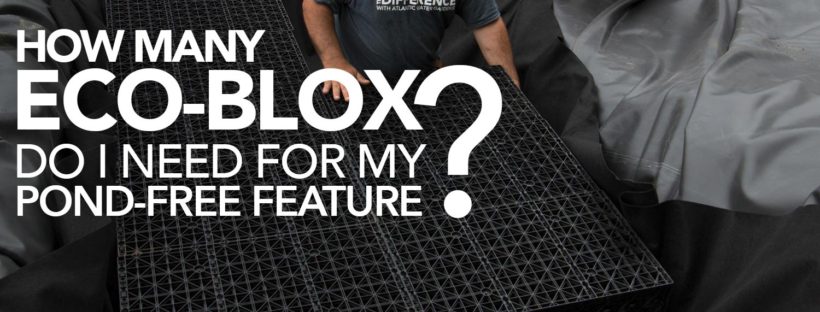
Pond-free features, where a pond or waterfall recirculates from an underground reservoir, have become very popular because they are easier to build and maintain than fish ponds. The Pond-free basin is a hole lined with EPDM rubber to make it waterproof, filled with water matrix boxes called Eco-Blox that can support thousands of pounds.
This weight-bearing reservoir can be hidden under gravel, lawn, pavers – you can even build waterfalls right on top of it! The water in Eco-Blox basins stays clean and clear, so maintenance is much simpler. Pond-free water features are generally safer too, because there’s no way for anyone to fall in.
With the great popularity of these features, we receive many questions. One of the main questions we get at Atlantic is “How many Eco-Blox do I need?”
Here’s how to figure that out.
First, find the volume of water needed to fill the stream and falls to overflowing.
Usually about 3” in the whole stream will do. Measuring everything in feet makes things easier, so convert 3” to a quarter of a foot. For a 6-foot by 2-foot stream:
Length x Width x 0.25 feet = 6’ x 2’ x 0.25’ = 3 cubic feet
We’ll want 3 times as much water in the reservoir as we need, so the level will only drop by a third when we turn the system on before it starts recirculating:
3 cubic feet x 3 = 9 cubic foot reservoir
Finally, we’ll divide by 4.3 cubic feet, the number of cubic feet in an Eco-Blox:
9 cubic feet ÷ 4.3 cubic feet/Eco-Blox = 2.1 Eco-Blox
With the addition of a Pump Vault to house and protect the pump, as well as providing a little extra water volume, 2 Eco-Blox will be perfect!
Now that you know how many Eco-Blox you’ll need for your next project, check out our video on how assemble one.
About the Author:

DEMI FORTUNA
Demi has been in water garden construction since 1986. As Atlantic’s Director of Product Information, if he’s not building water features, he’s writing or talking about them. If you have a design or construction question, he’s the one to ask.



I’m in the planning stage of reworking my existing pond system, which is around 1800 gallons and upgrading to around 4500 gallons system. I have a 10 foot diameter 26 inch deep horse trough that I plan to use as my reservoir and bog filter. The plan is to line it with eco-blox/aqua blox to about halfway up and cover that with a pond felt and rocks and plant the water plants a top that. There will also be a larger pump system than I have now and an external filtration system as well because I live in a hot state where algae is a real problem. My question is how many blocks and of what size will I need to make a layer in the bottom of the 10 foot diameter bog system? I want to make sure I leave about 6 to 8 inches of water on top for the plants and I also plan to move my two year old red ear sliders from indoors to outdoors during the summer to live in the bag area. Thanks for your advice in advance.
Sounds like a great filter/turtle pond! Full size blocks are 18″ tall, a layer of them would leave room for 4″ of gravel, plants, water and sliders with a 4″ lip on top to keep them from crawling out. If you want deeper gravel or more of a wall to keep the sliders in, go with the Ecoblox Small, which are 9″ tall but otherwise the same length and width. The question becomes, how many 27″ x 16″ rectangles fit in a 10′ circle? By area, how many 432 square inch blocks will fill a circle with a radius of 60 inches? 3600 x 3.14 / 432 = 26 blocks, but you’d have to do a lot of cutting and piecing, not to mention figuring out how to support the smaller pieces. Without cutting, you should be able to fit 8 blocks across the middle side by side, then another 5 or 6 on either side of those and you could fill the empty odd spaces with gravel.
– Demi